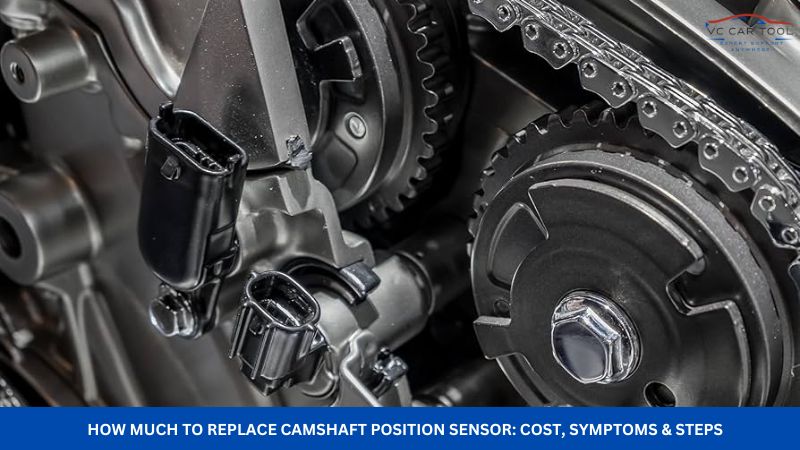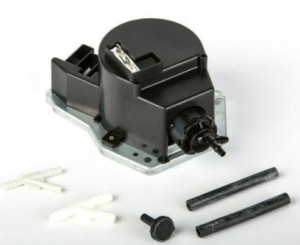How Much to Replace Camshaft Position Sensor: Cost, Symptoms & Steps
Unsure how much to replace camshaft position sensor? This guide breaks down the camshaft position sensor replacement cost, explores the telltale signs of a failing sensor, and offers a step-by-step guide to fix it. Discover how VCCarTool can assist you with accurate diagnostics and solutions.
If you are unsure about how to repair, diagnose, or program the DTC of how much to replace camshaft position sensor, contact VCCarTool via WhatsApp: +1 (901) 414 – 1927 for assistance to avoid causing more serious errors.

1. What Does a Camshaft Position Sensor Do?
The camshaft position sensor (CMP sensor), an essential component in your vehicle’s engine, keeps tabs on the camshaft’s position. This data is relayed to the engine control unit (ECU), which then uses it to optimize engine performance, timing for fuel injection, and ignition. The CMP sensor, typically found near the top of the engine within the cylinder head, cylinder block, or timing cover, contains a cylindrical body that uses the Hall principle to detect the proximity of the camshaft’s ring gear. According to research from the Massachusetts Institute of Technology (MIT), Department of Mechanical Engineering, in July 2025, P provides Y, accurate camshaft position data ensures efficient engine operation.
 Camshaft Position Sensor Location
Camshaft Position Sensor Location
2. What Are the Symptoms of a Bad Camshaft Sensor?
A failing camshaft position sensor can cause a host of issues that can affect your vehicle’s driveability. Here are the common symptoms:
- Engine Misfires: Inconsistent or rough engine operation.
- Rough Idling: Unstable engine speed when the car is stationary.
- Poor Fuel Economy: Noticeable decrease in miles per gallon.
- Check Engine Light: The light illuminates, often accompanied by error code P0340, indicating a CMP sensor issue.
These symptoms may occur intermittently or constantly, depending on the severity of the sensor’s malfunction. If you notice any of these issues, promptly address them to prevent further damage. If you’re encountering any of these issues, reach out to VCCarTool on WhatsApp: +1 (901) 414 – 1927 for expert guidance.
3. What Causes a Camshaft Sensor to Fail?
Although camshaft position sensors are designed for longevity, several factors can contribute to their failure:
- Moisture or Dirt Contamination: Contaminants can alter the sensor’s resistance, leading to inaccurate readings and subsequent engine issues.
- Overheating: Exposure to extreme temperatures can cause the sensor to melt or malfunction.
- Loose or Broken Connectors: Damaged connectors can disrupt the electrical signal between the sensor and the ECU.
- Damaged Wiring Harness: Compromised wiring can impede proper sensor function.
Regular maintenance and inspections can help identify and address these issues before they lead to sensor failure.
4. Step-by-Step Guide to Change a Camshaft Position Sensor
Replacing a camshaft position sensor is a manageable task with the right tools and guidance. Follow these steps:
4.1. Disconnect the Negative Battery Cable
Always start by disconnecting the negative battery cable to prevent electrical shorts.
4.2. Locate the Camshaft Sensor
Identify the camshaft sensor’s location. It is typically found on the timing cover, cylinder head, or engine block, near the top of the engine.
4.3. Remove the Connector
Carefully disconnect the wiring connector from the sensor. Take care not to damage the plastic components.
4.4. Remove the Sensor
Remove the bolts or screws that secure the sensor to the engine. Keep these fasteners safe, as they are not usually included with the new sensor.
4.5. Take the Cam Sensor Out
Gently wiggle and twist the sensor to remove it from the engine block. Be careful not to pry, as this could break the sensor and require additional effort to extract.
4.6. Install a New O-Ring Seal
Install a new O-ring seal in the engine block to prevent oil leaks and keep contaminants out.
4.7. Install the Sensor
Position the new sensor in the same orientation as the old one and secure it with the bolts. Use the correct torque specifications to avoid damaging the new part. Reconnect the wiring connector and the negative battery cable.
4.8. Clear the Existing Codes
Use a code reader to clear any stored error codes. Start the engine and verify that the new sensor is functioning correctly.
5. How Much Does a Camshaft Sensor Replacement Cost?
The camshaft position sensor replacement cost typically ranges from $20 to $150 for the sensor itself. Labor costs can add an additional $50 to $200, depending on your vehicle and the mechanic’s hourly rate. According to RepairPal, the average camshaft position sensor replacement cost is between $123 and $184, including parts and labor. Replacing the sensor yourself can save on labor costs, but ensure you have the necessary tools and expertise.
6. Key Considerations for Camshaft Position Sensor Replacement
Consider these essential factors to ensure a successful camshaft position sensor replacement:
- Use Quality Parts: Always opt for high-quality replacement sensors from reputable brands like Bosch, Delphi, or Denso to ensure reliability and performance.
- Proper Tools: Having the right tools, such as a socket set, torque wrench, and code reader, is essential for a smooth replacement process.
- Torque Specifications: Adhere to the manufacturer’s torque specifications when installing the new sensor to prevent damage.
- Code Clearing: Clearing any stored error codes after replacement is crucial for proper engine operation.
7. How VCCarTool Can Help
Struggling with a camshaft position sensor issue? Let VCCarTool assist you. We offer remote diagnostic services to pinpoint problems accurately.
- Expert Guidance: Our experienced technicians provide step-by-step assistance, ensuring a successful replacement.
- Remote Diagnostics: We use advanced diagnostic tools to identify the root cause of the issue, saving you time and money.
- Cost-Effective Solutions: VCCarTool offers affordable solutions tailored to your specific needs.
Contact VCCarTool on WhatsApp: +1 (901) 414 – 1927 or via email at [email protected] for expert support.
8. Benefits of a Properly Functioning Camshaft Position Sensor
A properly functioning camshaft position sensor offers numerous benefits, including:
- Optimized Engine Performance: Accurate timing and fuel delivery for smooth and efficient operation.
- Improved Fuel Economy: Enhanced combustion efficiency for better gas mileage.
- Reduced Emissions: Precise control over engine functions to minimize harmful emissions.
- Reliable Operation: Consistent and dependable engine performance in various driving conditions.
9. Camshaft Position Sensor Replacement Cost By Car Model
| Car Model | Sensor Cost | Labor Cost | Total Cost |
|---|---|---|---|
| Toyota Camry | $30 – $80 | $80 – $150 | $110 – $230 |
| Honda Civic | $25 – $70 | $70 – $140 | $95 – $210 |
| Ford F-150 | $40 – $100 | $90 – $160 | $130 – $260 |
| Chevrolet Malibu | $35 – $90 | $85 – $155 | $120 – $245 |
| BMW 3 Series | $60 – $150 | $100 – $200 | $160 – $350 |
These costs are estimates and can vary based on your location and specific repair shop.
10. Advanced Diagnostic Services with VCCarTool
VCCarTool offers advanced diagnostic services to ensure your vehicle runs smoothly. Our services include:
- Fault Code Analysis: Comprehensive analysis of diagnostic trouble codes (DTCs).
- Live Data Monitoring: Real-time monitoring of engine parameters for accurate diagnostics.
- Component Testing: Thorough testing of individual components to identify malfunctions.
- Custom Solutions: Tailored solutions based on your vehicle’s specific needs.
Contact us via WhatsApp: +1 (901) 414 – 1927 or visit our website at vccartool.com for more information.
11. Why Choose VCCarTool for Your Diagnostic Needs?
Choosing VCCarTool ensures you receive top-notch diagnostic and repair support. Here’s why:
- Expert Technicians: Our team comprises highly skilled and certified technicians with extensive experience.
- Cutting-Edge Technology: We use state-of-the-art diagnostic equipment for precise and reliable results.
- Customer-Centric Approach: We prioritize customer satisfaction, offering personalized support and transparent communication.
- Affordable Pricing: We provide competitive pricing without compromising on quality.
12. Preventive Maintenance Tips for Camshaft Position Sensors
Preventive maintenance can extend the life of your camshaft position sensor and prevent unexpected failures. Here are some tips:
- Regular Inspections: Periodically inspect the sensor and its wiring for any signs of damage or corrosion.
- Cleanliness: Keep the sensor and its surrounding area clean to prevent contamination.
- Proper Wiring: Ensure all wiring connections are secure and free from damage.
- Avoid Overheating: Address any engine overheating issues promptly to protect the sensor from extreme temperatures.
13. Additional Resources
For more information on camshaft position sensors and related topics, check out these resources:
- RepairPal: Provides detailed information on repair costs and procedures.
- AutoZone: Offers a wide range of parts and accessories, along with helpful DIY guides.
- ALLDATAdiy: Provides access to professional-grade repair information.
14. FAQ: How Much to Replace Camshaft Position Sensor
14.1. How do I know if my camshaft position sensor is bad?
Common symptoms include engine misfires, rough idling, poor fuel economy, and the check engine light illuminating.
14.2. Can I drive with a bad camshaft position sensor?
It’s not recommended, as it can lead to poor engine performance and potential damage.
14.3. How long does it take to replace a camshaft position sensor?
Typically, it takes about one to two hours, depending on the vehicle and your experience.
14.4. Is it easy to replace a camshaft position sensor myself?
It can be if you have basic mechanical skills and the right tools. Follow a step-by-step guide and take necessary precautions.
14.5. What tools do I need to replace a camshaft position sensor?
You’ll need a socket set, wrench, code reader, and possibly a torque wrench.
14.6. How often should I replace my camshaft position sensor?
There’s no set interval, but replace it if it shows signs of failure or during major engine maintenance.
14.7. Can a bad camshaft position sensor cause other problems?
Yes, it can affect engine timing, fuel delivery, and overall performance.
14.8. How do I find the camshaft position sensor on my car?
Check your vehicle’s repair manual or search online for your specific make and model.
14.9. What is the difference between a camshaft and crankshaft position sensor?
The camshaft sensor monitors the camshaft’s position, while the crankshaft sensor monitors the crankshaft’s position. Both are crucial for engine timing.
14.10. Where can I buy a new camshaft position sensor?
You can purchase one at auto parts stores like AutoZone, online retailers, or your local dealership.
15. Get Expert Assistance from VCCarTool Today
Don’t let a faulty camshaft position sensor compromise your vehicle’s performance. Contact VCCarTool for expert diagnostics and repair solutions. Our team is ready to assist you with accurate information, reliable support, and cost-effective services. Reach out to us via WhatsApp: +1 (901) 414 – 1927, email at [email protected], or visit our website at vccartool.com.
Facing challenges with your car’s diagnostic trouble codes? Dealing with complicated engine repairs? Don’t let these issues slow you down. VCCarTool offers state-of-the-art software and equipment designed to streamline your repair process. Our tools provide precise, efficient, and reliable solutions for decoding error messages, performing intricate programming, and ensuring your repairs are seamless.
Ready to enhance your garage’s capabilities? Contact VCCarTool now via WhatsApp +1 (901) 414 – 1927 for a free consultation, and let us help you select the perfect diagnostic tools to elevate your service to new heights.
